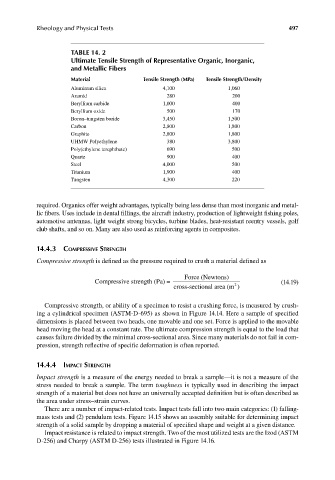Page 534 - Carrahers_Polymer_Chemistry,_Eighth_Edition
P. 534
Rheology and Physical Tests 497
TABLE 14. 2
Ultimate Tensile Strength of Representative Organic, Inorganic,
and Metallic Fibers
Material Tensile Strength (MPa) Tensile Strength/Density
Aluminum silica 4,100 1,060
Aramid 280 200
Beryllium carbide 1,000 400
Beryllium oxide 500 170
Boron–tungsten boride 3,450 1,500
Carbon 2,800 1,800
Graphite 2,800 1,800
UHMW Polyethylene 380 3,800
Poly(ethylene terephthate) 690 500
Quartz 900 400
Steel 4,000 500
Titanium 1,900 400
Tungsten 4,300 220
required. Organics offer weight advantages, typically being less dense than most inorganic and metal-
lic fibers. Uses include in dental fillings, the aircraft industry, production of lightweight fi shing poles,
automotive antennas, light weight strong bicycles, turbine blades, heat-resistant reentry vessels, golf
club shafts, and so on. Many are also used as reinforcing agents in composites.
14.4.3 COMPRESSIVE STRENGTH
Compressive strength is defined as the pressure required to crush a material defi ned as
Force (Newtons)
Compressive strength (Pa) = (14.19)
2
cross-sectional area (m )
Compressive strength, or ability of a specimen to resist a crushing force, is measured by crush-
ing a cylindrical specimen (ASTM-D-695) as shown in Figure 14.14. Here a sample of specifi ed
dimensions is placed between two heads, one movable and one set. Force is applied to the movable
head moving the head at a constant rate. The ultimate compression strength is equal to the load that
causes failure divided by the minimal cross-sectional area. Since many materials do not fail in com-
pression, strength reflective of specific deformation is often reported.
14.4.4 IMPACT STRENGTH
Impact strength is a measure of the energy needed to break a sample—it is not a measure of the
stress needed to break a sample. The term toughness is typically used in describing the impact
strength of a material but does not have an universally accepted definition but is often described as
the area under stress–strain curves.
There are a number of impact-related tests. Impact tests fall into two main categories: (1) falling-
mass tests and (2) pendulum tests. Figure 14.15 shows an assembly suitable for determining impact
strength of a solid sample by dropping a material of specified shape and weight at a given distance.
Impact resistance is related to impact strength. Two of the most utilized tests are the Izod (ASTM
D-256) and Charpy (ASTM D-256) tests illustrated in Figure 14.16.
9/14/2010 3:42:40 PM
K10478.indb 497 9/14/2010 3:42:40 PM
K10478.indb 497

